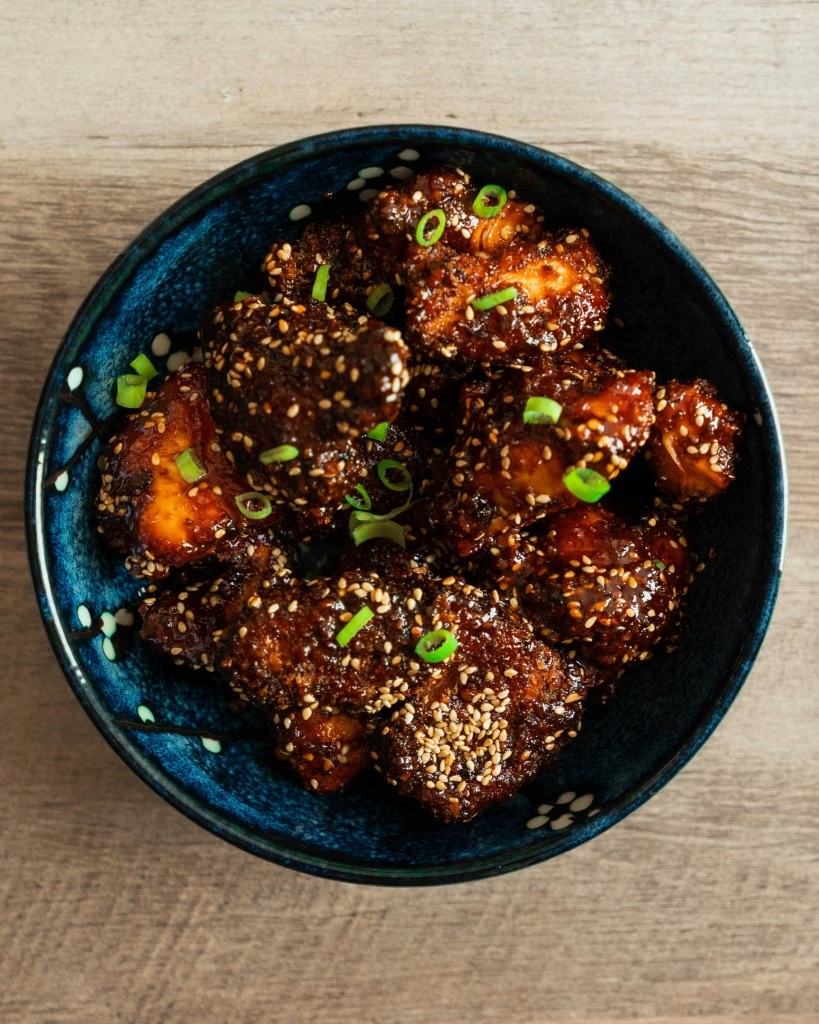Korean Fried Chicken, also known as “Yangnyeom Chicken” or “Dakgangjeong”, is more than just a crispy snack, it’s a global culinary sensation.
Unlike its Western counterpart, Korean Fried Chicken is celebrated for its ultra-crispy double-fried coating and flavorful sauces that strike the perfect balance between sweet, spicy, and savory. From bustling Seoul street stalls to high-end fusion restaurants, this dish has become a cultural phenomenon.
Whether you’re craving the fiery heat of gochujang or a sticky garlic-soy glaze, Korean Fried Chicken is the ultimate indulgence. In this article, we’ll walk you through everything you need to know to master this iconic recipe at home, from the ingredients and instructions to creative twists, common pitfalls, and a look back at its delicious history.
Table of Contents
Ingredients
Here’s what you’ll need for authentic, crispy Korean Fried Chicken with a sweet and spicy glaze:
For the Chicken:
- 1 kg (2.2 lbs) chicken wings or drumettes
- 1 teaspoon salt
- ½ teaspoon ground black pepper
- 1 tablespoon rice wine or mirin (optional)
- 1 cup potato starch or cornstarch
- ½ cup all-purpose flour
- 1 egg (optional, for extra binding)
- Vegetable oil for deep frying
For the Sauce (Yangnyeom):
- 2 tablespoons gochujang (Korean red chili paste)
- 2 tablespoons ketchup
- 2 tablespoons soy sauce
- 3 tablespoons honey or brown sugar
- 1 tablespoon rice vinegar
- 2 cloves garlic, minced
- 1 teaspoon grated ginger
- 1 tablespoon sesame oil
- 1 tablespoon water (to adjust consistency)
Garnish:
- Toasted sesame seeds
- Chopped green onions
Serves
This recipe serves 4 people as a main or up to 6 as a shared appetizer.
Step-by-Step Instructions
Step 1: Prep the Chicken
- Rinse and pat the chicken pieces dry with paper towels. Removing moisture helps crisp up the skin.
- Season with salt, pepper, and optionally rice wine or mirin. Let it marinate for 15–30 minutes.
Step 2: Make the Breading
- In a bowl, mix potato starch and all-purpose flour.
- Optionally beat in one egg for a slightly thicker crust.
- Dredge each chicken piece thoroughly, pressing the starch mixture onto the surface for extra crunch.
Step 3: First Fry
- Heat oil in a deep pot or wok to 160°C (320°F).
- Fry chicken in batches for 6–8 minutes until pale golden but not fully crisp.
- Remove and drain on a wire rack. Let rest for 10 minutes.
Step 4: Second Fry
- Reheat oil to 190°C (375°F).
- Fry the chicken again for 2–3 minutes until deep golden brown and extra crispy.
- Drain again on a rack. This second fry is the secret to Korean Fried Chicken’s signature crunch.
Step 5: Make the Sauce
- In a saucepan, combine gochujang, ketchup, soy sauce, honey, vinegar, garlic, ginger, sesame oil, and a little water.
- Simmer over medium heat for 3–5 minutes until thickened and glossy.
Step 6: Toss & Serve
- Toss the hot fried chicken in the sauce until well-coated.
- Sprinkle with sesame seeds and chopped green onions.

Serving Suggestions
- Serve hot with pickled radish (chikin-mu), a classic Korean side.
- Pair with cold beer, also known as “chimaek” (chicken + maekju, beer).
- Add steamed white rice and kimchi for a full meal.
- Make a fried chicken sandwich with coleslaw for a fusion twist.
Tips for Perfect Korean Fried Chicken
- Use potato starch for superior crispiness over flour alone.
- Double fry, this is non-negotiable for authentic texture.
- Let the chicken rest between fries to release moisture.
- Toss in sauce just before serving to maintain crispness.
- Use neutral oil like canola or sunflower for frying.
Healthier Alternatives
- Air fry or bake the chicken at 200°C (390°F) until golden. Lightly coat with oil spray.
- Use skinless chicken breast or thighs for less fat.
- Make a lighter sauce by reducing the sugar and omitting sesame oil.
- Serve with lettuce wraps, cucumber sticks, and vinegar slaw for a low-carb option.
Creative Variations
- Soy Garlic Korean Fried Chicken: Skip gochujang and use more garlic with soy sauce and sugar.
- Cheese Powder Chicken: Toss the fried chicken in a cheese-flavored seasoning (popular in Korea).
- Buffalo-Korean Fusion: Mix gochujang into classic buffalo sauce.
- Korean BBQ Fried Chicken: Use bulgogi-style marinade in the sauce.
- Korean Fried Cauliflower: Vegetarian version using cauliflower florets.
Common Mistakes to Avoid
- Skipping the double fry – One fry isn’t enough for that signature crunch.
- Not drying the chicken – Moisture = soggy skin.
- Overcrowding the pan – Fry in batches to avoid a drop in oil temperature.
- Using regular flour only – It won’t deliver that crispy coating.
- Saucing too early – Toss in sauce just before serving.
History of Korean Fried Chicken
Korean Fried Chicken might feel like a modern street food craze, but its story is deeply woven into Korea’s cultural and economic evolution. Unlike traditional Korean fare, deep-fried chicken wasn’t widely available until the mid-20th century, when American troops stationed in South Korea introduced fried chicken during the Korean War. It was first served during holidays and special events, making it a luxurious treat.

By the 1970s and 1980s, chicken had become more affordable and accessible in South Korea, thanks to industrial farming. This period saw the rise of Korean fried chicken chains like Pelicana and Kyochon, which started offering uniquely Korean styles of fried chicken with thin, crispy crusts and a variety of sweet, spicy, and garlicky sauces.
Today, Korean Fried Chicken is more than just a dish, it’s a cultural export. With the global rise of K-pop and K-dramas, Korean cuisine has gained immense popularity, and fried chicken remains one of its most iconic comfort foods, often enjoyed in social settings or during late-night hangouts.
FAQs About Korean Fried Chicken
1. What makes Korean Fried Chicken different from American fried chicken?
Korean Fried Chicken is double-fried for extra crispiness and coated in sweet, spicy, or savory sauces. It’s thinner and crunchier than American versions.
2. Can I make Korean Fried Chicken without gochujang?
Yes! Try soy garlic or honey butter variations if you don’t have gochujang.
3. What oil is best for frying Korean Fried Chicken?
Use neutral oils with a high smoke point like canola, vegetable, or sunflower oil.
4. Why is Korean Fried Chicken double fried?
Double frying removes moisture, giving it a long-lasting crisp even after saucing.
5. Can I make Korean Fried Chicken gluten-free?
Yes! Use gluten-free flour or starch and ensure all sauces (like soy sauce) are gluten-free.
6. How long can I store leftover Korean Fried Chicken?
Store in an airtight container in the fridge for up to 2 days. Reheat in an oven or air fryer for crispiness.
7. What’s the best cut of chicken to use?
Wings and drumettes are most popular, but you can use boneless thighs or breast too.
8. Is Korean Fried Chicken spicy?
It depends on the sauce. Gochujang-based sauces are mildly to moderately spicy, but you can adjust to taste.
9. Can I bake Korean Fried Chicken instead of frying?
Yes! Bake at 200°C (390°F), flipping halfway and brushing with oil for extra crispness.
10. What does “chimaek” mean in Korean?
“Chimaek” is a popular slang term combining “chicken” and “maekju” (beer). It’s a common combo for Korean fried chicken nights!
Korean Fried Chicken is more than just a crispy snack, it’s a testament to Korea’s culinary creativity and cultural evolution. From its humble beginnings during wartime to its current status as a global street food superstar, this dish continues to win hearts (and stomachs) with its irresistible combination of crunch, flavor, and flair.
Now that you know the secrets behind making authentic Korean Fried Chicken at home, it’s time to roll up your sleeves and fry up a batch. Whether you’re enjoying it solo or sharing it with friends over beer, one thing’s for sure, you’ll be going back for seconds!


